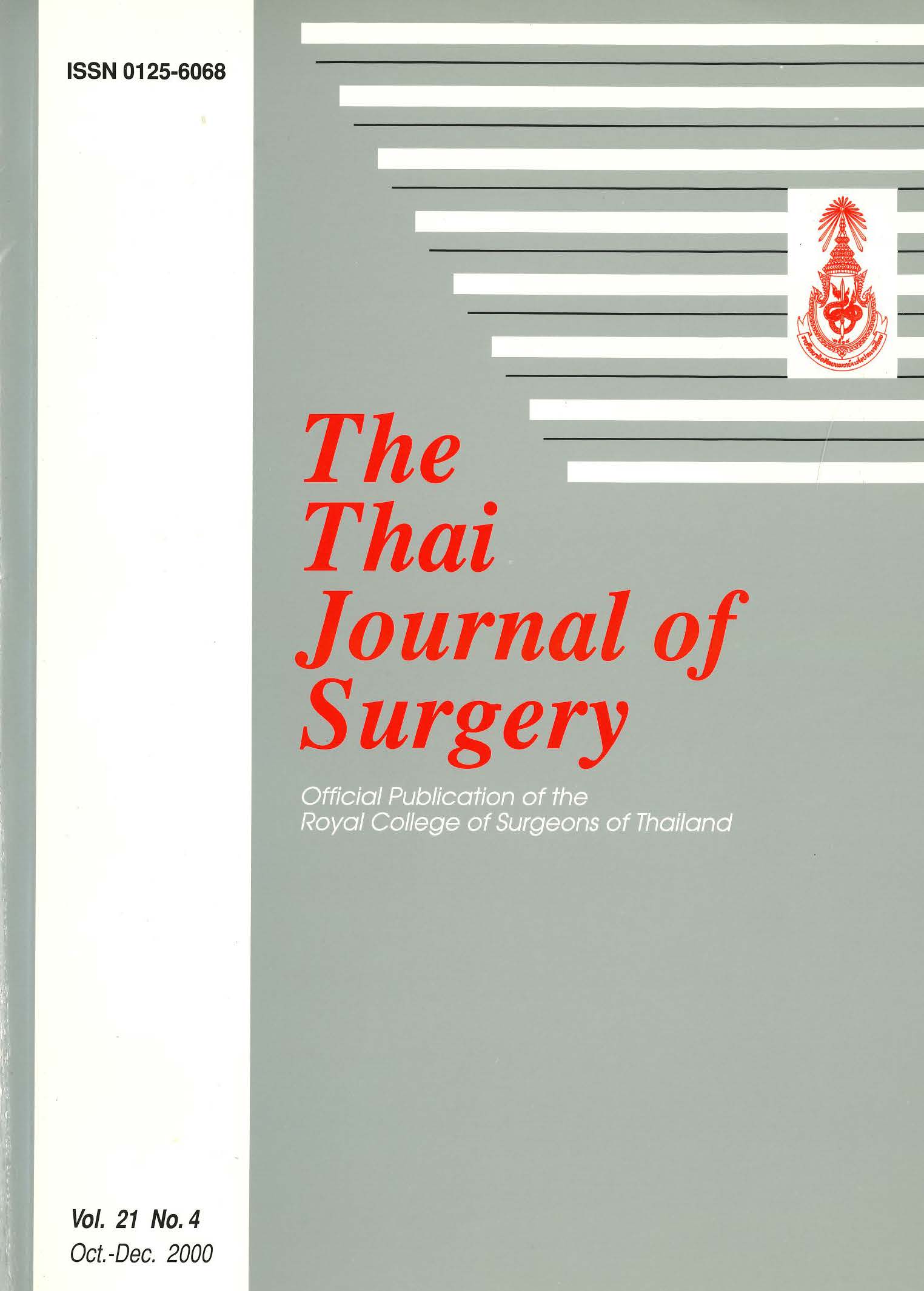Esophageal Atresia : Six-year Experience with 105 Cases
Abstract
Background: Care of infants with esophageal atresia has generally been improved. Data from previous review of 87 cases treated over a 10-year period (1983-1992) formed the basis for this follow-on study.
Materials and Methods: A retrospective study of 105 infants with esophageal atresia admitted to the Children's Hospital, Bangkok, during a 6-year period (1993-1998) was made.
Results: The incidence was 1.2 : 10,000 live births. The most common type, esophageal atresia with distal tracheoesophageal fistula, was noted in 90 percent of cases. Risk factors influenced against survival included birth weight below 2,000 grams and cardiac anomalies. Associated anomalies were detected in 65 percent of cases. Primary repair of the esophagus was done in 21 patients, while delayed repair was done in 57 infants. Esophageal replacement was necessary in 3 cases. The most frequent postoperative complication was atelectasis. The overall mortality rate was 59 percent.
Conclusion: Results from this current review were comparable with those of previous study. No significant improvement was discerned since the majority of patients were in poor-risk group. More effort has been made in detecting associated anomalies.
References
2. Spitz L. Esophageal atresia: past, present, and future. J Pediatr Surg 1996; 31: 19-25.
3. Beasley SW, Myers NA. Trends in mortality in oesophageai atresia. Pediatr Surg Int 1992; 7: 86-9.
4. Louhimo I, Lindahl H. Esophageal atresia: primary results of 500 consecutively treated patients. J Pediatr Surg 1983; 18:217-29.
5. Anuntkosol M. Esophageal atresia: review of 87 cases, Bull Dept Med Serv 1996; 21: 220-9 (in Thai),
6. Waterston DJ, Bonham Carter RE, Aberdeen E. Oesophageal atresia: tracheo-oesophageal fistula. A study of survival in 218 infants. Lancet 1962; 1: 819-22.
7. Statistical Report. Rajavithi Hospital, 1993-1998.
8. Bankier A, Brady J, Myers NA. Epidemiology and genetics. In: Beasley SW, Myers NA, Auldist AW, eds. Oesophageal atresia. London: Chapman & Hall, 1991: 19-29.
9. Cudmore RE. Oesophageal atresia and tracheo-oesophageal fistula. In: Lister J, Irving IM, eds. Neonatal surgery. London: Butterworths, 1990: 231-58.
10. Myers NA, Beasley SW, Auldist AW. Oesophageal atresia and associated anomalies: a plea for uniform documentation. Pediatr Surg Int 1992; 7: 97-100.
11. Holder TM, Cloud DT, Lewis JE, Pilling GP. Esophageal atresia and tracheoesophageal fistula: a survey of its members by the Surgical Section of the American Academy of Pediatrics. Pediatrics 1964; 34:542-9.
12. Holder TM, Ashcraft KW, Sharp RJ, Amoury RA. Care of infants with esophageal atresia, tracheoesophageal fistula, and associated anomalies. J Thorac Cardiovasc Surg 1987;94:828-35.
13. Chittmittrapap S, Spitz L, Kiely EM, Brereton RJ. Oesophageal atresia and associated anomalies. Arch Dis Child 1989; 64:364-8.
14. Ein SH, Shandling B, Wesson D, Filler RM. Esophageal atresia with distal tracheo-esophageal fistula: associated anomalies and prognosis in the 1980's. J Pediatr Surg 1989; 24: 1055-9.
15. Strodel WE, Coran AG, Kirsh MM, Weintraub WH, Wesley JR, Sloan H. Esophageal atresia: a 41-year experience. Arch Surg 1979; 114: 523-7.
Downloads
Published
How to Cite
Issue
Section
License
Articles must be contributed solely to The Thai Journal of Surgery and when published become the property of the Royal College of Surgeons of Thailand. The Royal College of Surgeons of Thailand reserves copyright on all published materials and such materials may not be reproduced in any form without the written permission.



